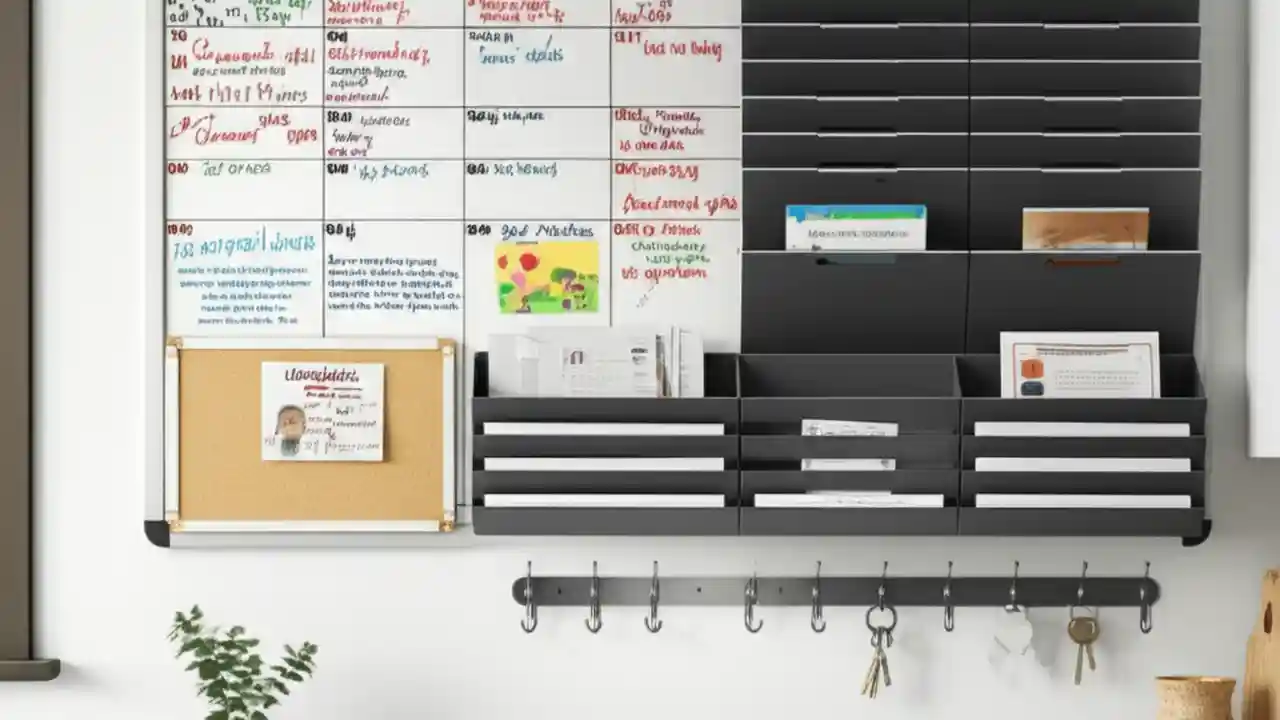The most practical way to simplify your daily life is to intentionally manage three core areas: your time, your space, and your decisions. By creating simple routines, decluttering your environment, and automating repetitive choices, you reclaim mental energy and create a profound sense of calm. I’ve spent two decades helping people untangle their lives, and this principle is the foundation of it all.
Feeling overwhelmed is a modern epidemic, but the cure isn’t a radical, life-altering overhaul. It’s about small, consistent adjustments. This guide provides a realistic, step-by-step action plan to help you simplify your daily life, not just for a week, but for good.
We will explore actionable strategies for mastering your schedule, decluttering both your physical and digital worlds, streamlining your finances, and most importantly, cultivating a mindset that embraces simplicity. Think of this as your definitive roadmap to a less chaotic, more intentional existence.
Table of Contents
Mastering Your Time & Routine
Your time is your most finite resource. Simplifying how you use it isn’t about doing less; it’s about doing what matters with less friction. A well-designed routine acts as the scaffolding for a simpler day, removing the mental load of “what’s next?” and freeing you up to just be.
How can I create a simple daily routine that I’ll actually stick to?
The secret to a routine that sticks is starting incredibly small. Don’t try to transform your entire day overnight. Instead, anchor one or two new habits to existing ones. This is a technique called “habit stacking.” For example, after you brush your teeth (an existing habit), you’ll do ten minutes of stretching (your new habit).
Focus on bookending your day. A simple morning and evening routine can have an outsized impact on your entire day. Here’s a sample starter framework:
- Simple Morning Routine: Wake up, drink a glass of water, stretch for 5 minutes, get dressed. That’s it. Don’t check your phone for the first 30 minutes. This small buffer prevents the world’s demands from hijacking your day before it even begins.
- Simple Evening Routine: Set out your clothes for tomorrow, do a 10-minute “tidy-up” of the main living area, read one chapter of a book. This prepares you for a smoother morning and helps your mind disengage from the day’s stress.
Track your consistency for one week. The goal isn’t perfection, but progress. Once these small habits feel automatic, you can then consider adding another small element.
What is the ‘two-minute rule’ and how does it simplify tasks?
The “two-minute rule,” popularized by productivity consultant David Allen, is a game-changer for procrastination. The rule is simple: If a task takes less than two minutes to complete, do it immediately.
This isn’t about productivity for its own sake; it’s about preventing the buildup of small, nagging tasks that create mental clutter. Think about it: putting your dish in the dishwasher, responding to a quick email, hanging up your coat, or wiping down a counter. Each of these takes less than two minutes.
When you let these tiny tasks pile up, they become a mountain on your to-do list, a constant visual reminder of things left undone. By tackling them instantly, you keep your physical and mental space clear. It’s one of the most effective ways to feel more in control and less burdened by the minutiae of daily life.
How can I stop procrastinating on small, everyday chores?
Beyond the two-minute rule, a technique I call “task batching” works wonders. Instead of letting chores interrupt you throughout the day, group similar tasks together into a dedicated time block. This is more efficient because your brain stays in the same “mode.”
For example, create a “power hour” once or twice a week. During this hour, you might:
- Pay all upcoming bills.
- Respond to non-urgent personal emails.
- Schedule appointments for the coming weeks.
- Make a grocery list for the week.
Another powerful tool is setting a timer. The idea of “cleaning the kitchen” can feel daunting. But “cleaning for 15 minutes” feels manageable. Set a timer and just start. More often than not, you’ll find the initial inertia was the biggest hurdle, and you might even continue after the timer goes off.
What are the best ways to simplify my morning routine?
A simplified morning sets the tone for a simplified day. The goal is to reduce the number of decisions you have to make before you’ve even had your coffee. Here are some of the most effective strategies I’ve seen work for hundreds of people.
| Strategy | How It Simplifies Your Morning | Practical Example |
|---|---|---|
| Prepare the Night Before | Removes morning decision-making and rushing. | Lay out your clothes, pack your gym bag, prep your coffee maker, and pack your lunch. |
| Create a “Launch Pad” | Eliminates the “where are my keys?” panic. | Designate a bowl or hook by the door for your keys, wallet, and sunglasses. Everything you need to leave the house is in one spot. |
| Automate Breakfast | Reduces one more food decision and saves time. | Have the same simple, healthy breakfast every weekday (e.g., oatmeal, a smoothie, or yogurt with berries). |
| No-Phone First 30 | Protects your focus and prevents reactive stress. | Keep your phone on airplane mode or in another room for the first 30 minutes after you wake up. Use an old-fashioned alarm clock. |
Decluttering Your Physical & Digital Space
Your external environment is a direct reflection of your internal state. A cluttered home or a chaotic digital life drains your energy and focus. Simplifying your space is not about sterile minimalism; it’s about making sure that everything you own serves a purpose or brings you joy.
What’s a simple, non-overwhelming way to start decluttering my home?
The biggest mistake people make is trying to declutter their entire house in one weekend. This leads to burnout and a bigger mess than when you started. Instead, use the “one-drawer” method.
Pick one, just one, small area. It could be a junk drawer in the kitchen, your nightstand, or a single shelf in your closet. Set a timer for 15-20 minutes and tackle only that space. Pull everything out, quickly sort it into three piles (Keep, Donate/Sell, Trash), and put the “Keep” items back in an organized way. That’s it. You’re done for the day.
The feeling of accomplishment from this small win will build momentum. Maybe tomorrow you’ll do another drawer. The next week, a whole closet. This slow and steady approach prevents overwhelm and makes the process sustainable.
How do I organize my digital life (emails, files, photos)?
Digital clutter is just as stressful as physical clutter. The principles are the same: delete, group, and automate.
- Email: Embrace the “one-touch” rule. When you open an email, decide its fate immediately: reply, archive/file, or delete. Don’t let it sit in your inbox. Aggressively unsubscribe from promotional lists you no longer read. Use services like Unroll.Me to bundle subscriptions into a single daily email.
- Files: Create a simple, top-level folder structure on your computer. For most people, something like `Work`, `Personal`, `Finances`, `Projects` is enough. Be ruthless about deleting old downloads and temporary files. Schedule a 15-minute digital cleanup at the end of each week.
- Photos: This is a big one. The key is to process photos regularly. At the end of each month, go through your phone’s camera roll. Delete the duplicates, the blurry shots, and the screenshots you no longer need. Create albums for important events. This prevents the daunting task of sorting through 10,000 photos years from now.
What is a ‘capsule wardrobe’ and can it simplify my life?
A capsule wardrobe is a small collection of essential, versatile clothing items that you love to wear, which can all be mixed and matched. The goal isn’t deprivation; it’s to eliminate decision fatigue and the “closet full of clothes but nothing to wear” syndrome.
It radically simplifies your life by:
- Saving Time: Getting dressed takes minutes because everything works together.
- Saving Money: You buy fewer, higher-quality pieces and avoid impulse buys.
- Reducing Stress: No more morning wardrobe anxiety.
You don’t need to follow a strict 37-piece rule. Just start by identifying your most-worn, most-loved items. Build your wardrobe around a neutral color palette (like black, navy, white, grey) and add a few accent colors. It’s a journey of discovering your personal style and finding freedom in having less.
Simplifying Finances & Decisions
Financial stress and decision fatigue are two of the biggest thieves of peace. Simplifying in these areas means creating systems that run in the background, freeing up your cognitive bandwidth for more important things.
What are practical tips for simplifying my personal finances?
Financial complexity creates anxiety. The goal is to automate as much as possible and reduce the number of accounts you have to manage.
- Automate Savings & Bill Pay: Set up automatic transfers to your savings account the day you get paid. This “pay yourself first” method ensures you’re saving without thinking about it. Do the same for all recurring bills like rent, utilities, and loan payments.
- Consolidate Accounts: Do you have multiple old 401(k)s, several checking accounts, or a dozen credit cards? Consolidate them. Roll old retirement accounts into a single IRA. Use one primary checking account and one or two primary credit cards (e.g., one for daily spending, one for travel rewards).
- Adopt a Simple Budgeting Method: Forget complex spreadsheets. Try the 50/30/20 rule: 50% of your after-tax income goes to Needs (rent, groceries), 30% to Wants (dining out, hobbies), and 20% to Savings and Debt Repayment. It’s a simple framework to guide your spending without micromanaging every penny.
How can I reduce ‘decision fatigue’ in my daily life?
Decision fatigue is the deteriorating quality of your decisions after a long session of decision-making. Simplifying your life is the ultimate antidote. You’ve already seen several strategies: automating breakfast, a capsule wardrobe, the two-minute rule. Here are a few more:
| Area of Life | Simplification Tactic | Benefit |
|---|---|---|
| Groceries | Create a rotating two-week meal plan. | Eliminates the daily “what’s for dinner?” question and streamlines grocery shopping. |
| Workouts | Have a default workout for each day (e.g., Monday is run day, Tuesday is strength). | Removes the need to decide what to do at the gym. You just show up and execute. |
| Social Plans | Set a ‘social budget’ of 2-3 outings per week. | Prevents over-committing and makes it easier to say ‘no’ when you’ve hit your limit. |
| Information Diet | Limit news consumption to twice a day for 15 minutes. | Reduces cognitive load from constant updates and outrage cycles. |
Cultivating a Simple Mindset
True simplification is an inside job. You can declutter your home and schedule, but if your mind is chaotic, your life will feel complex. Cultivating a simple mindset is about learning to focus on what truly matters and letting go of the rest.
How does mindfulness help in simplifying life?
Mindfulness is simply the practice of paying attention to the present moment without judgment. It simplifies life by pulling you out of the mental chaos of worrying about the future or ruminating on the past. When you’re washing dishes, just wash the dishes. Feel the warm water, see the soap bubbles. You’re not mentally rehearsing a difficult conversation or making a to-do list.
This practice, even for just a few minutes a day, trains your brain to be less reactive. You start to notice the gap between an event and your reaction to it. This space is where you find the freedom to choose a simpler, calmer response instead of an automatic, stressed-out one.
What does it mean to ‘set boundaries’ and how does it simplify relationships?
Setting boundaries means clearly defining what you are and are not okay with. It’s about protecting your time, energy, and emotional well-being. Without boundaries, you end up over-committed, resentful, and drained. It’s a direct path to a complicated life.
Simplifying relationships through boundaries looks like:
- “I can’t take on that extra project at work right now, as my plate is full.”
- “I’d love to see you, but weeknights are my family time. How about we get together on Saturday?”
- “I appreciate you sharing, but I don’t have the emotional capacity to discuss this topic right now.”
Clear boundaries lead to healthier, simpler relationships because expectations are clear and your resources are not constantly being depleted.
How can I learn to say ‘no’ without feeling guilty?
For many of us, saying ‘no’ feels like we are letting someone down. The key is to reframe it. You are not saying ‘no’ to the person; you are saying ‘yes’ to your own well-being, your priorities, and your peace of mind.
Try the “Polite Decline” formula:
1. **Acknowledge & Appreciate:** “Thank you so much for thinking of me.”
2. **State the ‘No’ Clearly:** “Unfortunately, I won’t be able to.” or “I can’t commit to that right now.”
3. **Give a Vague Reason (Optional):** “My schedule is packed.” or “I’m focused on other priorities at the moment.” You do not owe a detailed explanation.
4. **Offer an Alternative (If you want):** “I can’t help with the event, but I’d be happy to share the flyer on my social media.”
Every time you say ‘no’ to something that doesn’t align with your goals, you are creating space for the things that do. It is the ultimate act of life simplification.
Conclusion
Simplifying your life isn’t a destination you arrive at, but a continuous and rewarding practice. It’s about consciously choosing where to direct your precious energy. By implementing small, consistent changes in your routines, your environment, and your decisions, you trade chaos for calm and distraction for focus.
Remember the core principle: manage your time, space, and decisions with intention. Start small, be consistent, and give yourself grace. The result is a life that is not just simpler, but richer and more aligned with what truly matters to you. If you found this guide helpful, please consider sharing it with someone who could also benefit from a simpler path.







